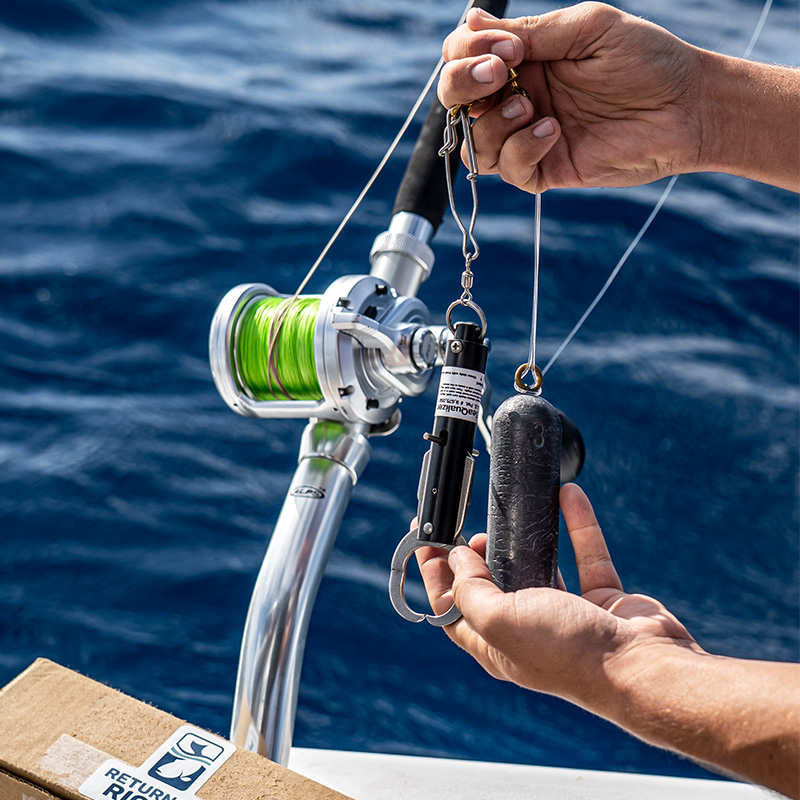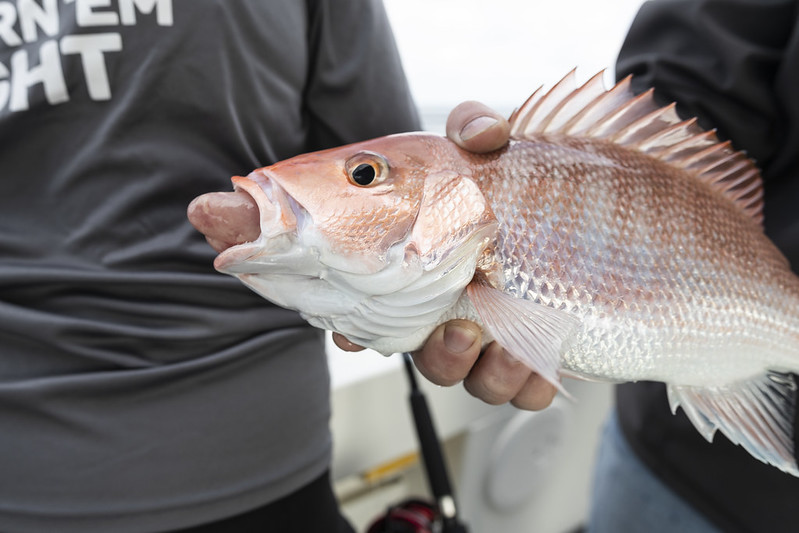Reef species are so popular on the table that the last thing most of us want to think about is releasing them after the catch. But with tight harvest rules on most species these days, catch and release is a part of nearly every bottom-fishing trip. Many fish that come over the rail will be too small, the wrong species, or may put you over your daily bag limit.
If you bring up one of these fish from water over much over 65 feet deep, odds are good it will suffer “barotrauma” which is basically the bends in fish, plus added complications as their swim bladder can push the stomach out of their mouth from the rapid pressure change as they’re brought to the surface. Some fish experience the problem in water as shallow as 35 feet, and nearly all of them do if brought up from 90 feet or more, fisheries biologists tell us.
Per biologists with Louisiana Fish & Wildlife, symptoms include:
- Stomach protruding from the mouth
- Bulging eyes
- Bloated midsection or distended intestines
- Sluggish swimming or inability to swim downward
- Lifted or bubbly scales.
If you release fish with any of these symptoms without treatment, odds are very high that they won’t survive long. They either die from the trauma or they’re eaten by sharks as they drift on or near the surface.

Barotrauma often includes the stomach protruding through the mouth and bulging eyeballs, both signs of a severe case of “the bends” in fish. (ReturnEmRight)
This is not only an obvious waste of the resource, but it can also impact future catches which can result in ever tighter harvest rules.
An average angler might be catching three or four fish or more that have to be released for each of the few legal ones that go in the box. If those released fish don’t survive, the numbers add up quickly. If we waste 75 percent of the fish we hook, it doesn’t take long for federal and state agency testing data to start showing declines, and that results in either tighter limits or fewer open days of fishing, neither of which any of us want.
Bottom line is it’s in our own best interests to make sure as many fish as possible survive the catch and release process.
By law, any anglers fishing for reef fish in the Gulf must now carry aboard and make use of dehooking and descending devices aimed at improving survival.
The DESCEND Act, which went into effect on January 13, 2022, requires anglers to have a venting tool or descending device onboard while reef fishing in federal waters of the Gulf.
Here are the requirements:
Any boat harvesting or attempting to harvest reef species (primarily grouper and snapper but other species are included as well) must have a “descending device” or venting tool aboard: Here are the basics:
- An instrument capable of releasing a fish at the depth from which the fish was caught must be aboard.
- The device must be rigged and ready for use when fishing.
- The device is composed of a weighted hook, lip clamp, or box that will hold the fish while it is lowered to depth. The system must then release the fish promptly.
- The rule sets a minimum of 16-ounces of weight and a minimum length of 60 feet of line attached to the descending device.
According to researchers, when a fish gets back to the depth where it was caught, its equilibrium is restored and it can make a dash for cover before sharks or goliath grouper home in on it in most cases..
Basically the trick of getting the fish back to depth quickly is a matter of plenty of weight, and a method of releasing them once they’re back near home. Not all of them make it, even when sent back down quickly, but researchers say about 80 percent do, which is way better than the 100 percent that die if they’re not sent back down.

The Seaqualizer is one of several descending devices that quickly get fish back to safe depths and release them there. (ReturnEmRight)
The devices are not expensive. The SeaQualizer is looks somewhat like a BogaGrip fish gripper. It can be set to release at 50, 100, or 150 feet and can be used to release fish caught in water up to 300 feet, on the theory that if you send the fish back to half the depth it came up from, it will probably survive.
The FishSaverPro is basically a large, barbless hook with a line attachment at the back of the bend. You just clip a large weight—10 to 16 ounces is best, to the eye clip, attach the fish and send it plunging. The weight keeps the hook pulled into the jaw until it gets deep, and then when you hit the brakes on the line, this pulls on the bend of the hook and jerks it out of the mouth. The result of which is that the fish is free.
The Shelton Fish Descender is even less costly. It’s designed primarily for smaller bottom species. It’s basically a heat-treated wire shaped more or less like a hook, again with a line attachment on the bend as well as at the eye, and it works in the same way.
Proper Bottom Fishing Catch And Release: The Venting Process
The rules require that any boat harvesting or attempting to harvest reef species must also have aboard a venting tool with these capabilities:
- Must be capable of penetrating the abdomen of a fish to release the excess gases accumulated in the body cavity when a fish is retrieved from depth.
- Must be a sharpened, hollow instrument that allows air to escape, such as a hypodermic syringe with the plunger removed.
- The rule sets as a minimum a 16–gauge needle, which has an outside diameter of 0.065 inches, as the minimum diameter hollow tube that must be used.
- Fishermen may also choose to use a larger diameter hollow needle because it will allow air to escape from a fish faster.
- A tool that is not hollow, such as a knife or an ice pick, does not meet the requirements of a venting tool, and must not be used to vent a fish.
Researchers say that venting most fish does them no permanent harm, with the small puncture wound in the belly soon healing.

Descending devices lower the fish quickly back to at least half the depth they came from before releasing them. (ReturnEmRight)
The “Return Em Right” Program—and Free Stuff
To encourage more anglers to become aware of the rules and do their share in preserving the reef fish resource, the “Return ‘Em Right” program was developed by the National Oceanic and Atmospheric Administration (NOAA), Florida Sea Grant, the University of Florida’s Marine Sciences Department and the Gulf States Marine Fisheries Commission.
According to Nick Haddad, Sustainable Fisheries Communications Manager for Florida Sea Grant, this $30 million project was selected and funded by the Deepwater Horizon Open Ocean Trustee Implementation Group as part of the 2019 Open Ocean Restoration Plan. Reef fish species were substantially harmed by the 2010 Deepwater Horizon oil spill.
The agencies are working with a coalition of anglers, small businesses, industry groups, state agencies, universities, government and non-government organizations committed to maintaining healthy fish stocks and fishing access in the Gulf.
The project also will conduct post-release monitoring and studies to assess effectiveness of the work and evaluate the success of training and outreach efforts. This information will be shared with anglers at outreach events.

This red snapper is headed back to a safe landing on the reef below. (NOAA-Adrian Gray)
It’s hoped that these catch and release fishing efforts will help increase the number of fish that get back down to depth safely, enhance angler contributions to reducing reef fish mortality, and provide improved fishing experiences.
And there’s a bonus. Gulf reef fish anglers who fish for federally managed Gulf reef fish like snapper or grouper are eligible to take the online training of best practices and upon completion receive $100 worth of release gear for free.
The gear package includes:
- One pre-rigged Standard SeaQualizer™ Descending Device attached to lead weight using a three-way swivel
- One SeaYaLater Fish Release Hook
- One Return ‘Em Right brochure
- One Return ‘Em Right sticker
Sign up here and do your part in the catch and release effort to preserve our access to quality reef fish action for now and in the future: https://returnemright.org.


